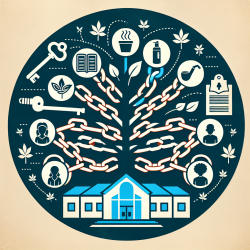Introduction
As practitioners dedicated to improving outcomes for children, it is crucial to integrate evidence-based practices into our daily work. The research article "Monitoring quality and coverage of harm reduction services for people who use drugs: a consensus study" provides valuable insights that can be applied to enhance service delivery and outcomes. This blog will explore how practitioners can implement the findings from this study to improve their skills and encourage further research in harm reduction services.
Understanding Harm Reduction Indicators
The study presents a framework for developing and evaluating indicators that monitor the quality and coverage of harm reduction services. These indicators are essential for assessing the effectiveness of interventions aimed at reducing health and social problems among people who use drugs. By understanding and utilizing these indicators, practitioners can ensure that their services are aligned with best practices and effectively address the needs of their clients.
Implementing Evidence-Based Practices
Practitioners can enhance their skills by implementing the following evidence-based practices derived from the study:
- Opioid Agonist Therapy (OAT) Indicators: Focus on coverage, waiting list time, dosage, and availability in prisons. Ensuring these indicators are met can significantly improve the quality of care provided to clients.
- Needle and Syringe Programmes (NSP) Indicators: Prioritize coverage, the number of needles/syringes distributed/collected, provision of other drug use paraphernalia, and availability in prisons. These indicators help reduce the risk of infections and promote safer practices among clients.
- Generic Cross-Cutting Indicators: Emphasize infectious diseases counseling and care, take-home naloxone, information on safe use/sex, and condom distribution. These indicators support a holistic approach to harm reduction and improve overall health outcomes.
Encouraging Further Research
While implementing these indicators is a significant step forward, practitioners should also be encouraged to conduct further research to refine and expand the framework. This includes piloting the proposed indicators to test their feasibility and applicability in different settings. By actively engaging in research, practitioners can contribute to the continuous improvement of harm reduction services and ensure that they remain effective and relevant.
Conclusion
Incorporating evidence-based harm reduction indicators into practice is essential for enhancing practitioner skills and improving outcomes for children. By focusing on quality and coverage, practitioners can ensure that their services are aligned with best practices and effectively address the needs of their clients. To read the original research paper, please follow this link: Monitoring quality and coverage of harm reduction services for people who use drugs: a consensus study.










